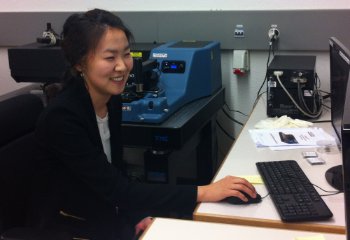Mar 5 2013
Researchers at EPFL in Switzerland are measuring the mechanical properties of proteins, cells and tissues. To date, AFM has been the main tool but is now complemented with the arrival of a nanoIR™ AFM-IR system from Anasys.
 Experienced microscopist, Dr. Sunny Jeong from EPFL using the Anasys nano-IR
Experienced microscopist, Dr. Sunny Jeong from EPFL using the Anasys nano-IR
Dr Andrzej Kulik is a research associate in the Laboratory of the Physics of Living Matter at the EPFL in Switzerland. Under the leadership of Professor Giovanni Dietler, the research activity of the laboratory of physics of living matter is mainly devoted to the study of DNA topology, cellular machines, protein mechanics and high-resolution low temperature Atomic Force Microscopy (AFM). Through internal and external collaborations, a certain number of other research activities are carried out in particular on knots hydrodynamics, DNA gel electrophoresis, cell elasticity, cell motility, etc.
Describing his work, Kulik says "the nanoIR is presently used in two projects - antibiotic resistant bacteria, and transformation of Aß42 monomers to amyloid cross ß-sheets. The chemical analysis at submicron scale allows us to study small quantities of difficult-to-get proteins or even just one single bacterium at a time. It is supposed that antibiotic-resistant bacteria have a different IR spectra to non-resistant ones. If this technique is successful, it will allow us to determine quickly and at the single bacteria level the type of bacteria contained in the sample. Functional imaging is especially practical when an IR absorption image at the nanoscale can be quickly obtained using one, well-chosen wavelength. Using the system to date, we have been amazed by the extremely low noise of the AFM part of nanoIR which gives us excellent resolution."
Prior to using AFM-IR, Kulik applied multiple electron and atomic force microscopes to his research. He also used scanning near-field and acoustic microscopies. With his Anasys system, Kulik is making nanoscale measurements with the combination of AFM and IR spectroscopy. "Our specimens are of an optimum size for the nanoIR work. Together with its open architecture design and excellent applications support have allowed us to attempt novel experiments. In short, the full potential of the technique is still for us to discover!"
For more information on AFM-IR and its applications, please visit the Anasys web site: www.anasysinstruments.com.